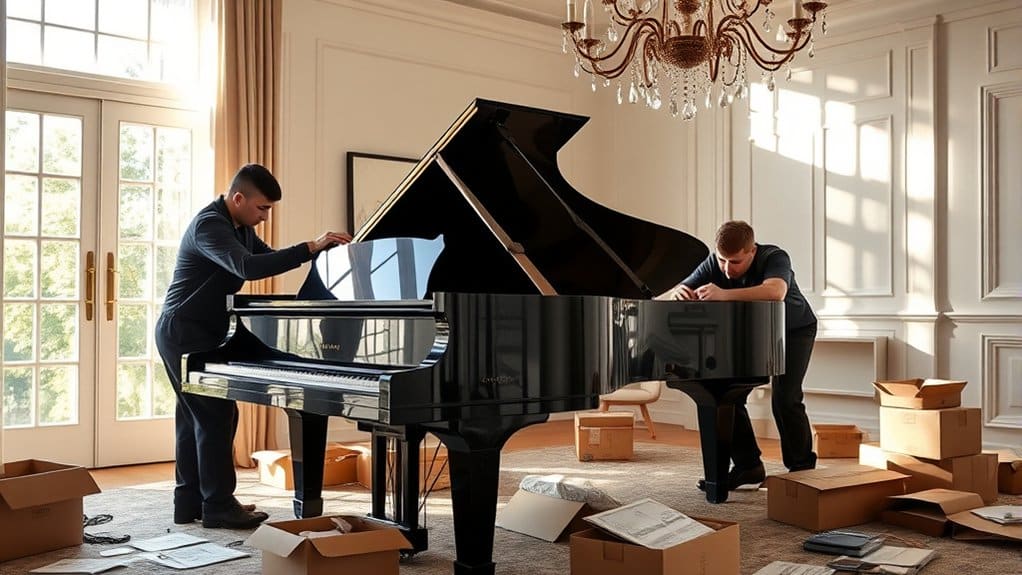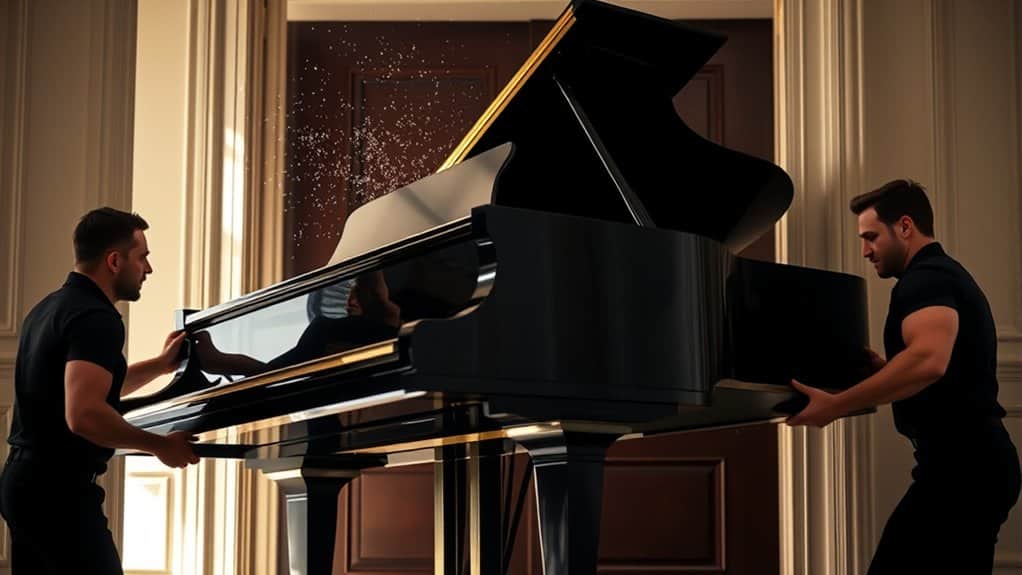Pianos are commonly found in many households and businesses across the United States. They are also notoriously difficult pieces to move without incurring some sort of damage due to their size, weight, and fragile nature. They are also extremely expensive to repair, much less replace, so any time a piano needs to be relocated, it should be done only after the most judicious and detailed planning and preparation have been executed.
In this article we will look at the best standards and practices for moving several styles of piano. But first, as with any moving project, let us examine the preparation needed for such a job.
Measurements and Planning
- You will need to map out your path of movement both in the current location and the subsequent destination. Move furniture and other items out of the path and remove any doors if extra room is needed.
- Measure the piano as well as the hallways, doors, and other entry or exit points. Make sure you have sufficient clearance at all times. This is not a problem you want to discover as you are moving the piano.
- Lay down floor protection. A piano is very heavy and could leave marks or scuffs on hardwood flooring.
- Use a ramp for any stairs or steps that may be involved in the move.
- Secure assistance. It may take up to four men to securely and safely maneuver a piano.
- Due to the weight of the piano, always wear closed-toed shoes, gloves and back belts.

Your Moving Supplies
Have all of your supplies on hand before beginning the move. Again, you do not want to halt the process because you do not have what you need. And what you will need to do this safely are:
- Moving blankets
- A dolly or hand truck
- Lifting straps
- Tie down straps (ratchet variety)
- Packing tape
- Work gloves
Transporting an Upright Piano
Upright pianos are smaller and easier to maneuver than their grand or baby grand counterparts. You need to make sure the keys and pedals are well protected, and you should begin by placing the lid over the keyboard and securing it in place with packing tape. The pedals should be wrapped in stretch wrap and again secured with tape. Then wrap all sides of the piano with moving blankets to protect both the piano and your walls.
Upright pianos weigh between 6090-1500 pounds, so use lifting straps to lift the piano and place it on your dolly, then roll to the moving truck and use ratchet straps to tie it down securely. It is advisable to load your piano in the truck first, as this helps balance the load and will help protect the piano from damage.
Transporting a Grand Piano
Grand pianos are a completely different proposition altogether, in that they have to be disassembled for transport, making them much more time-consuming than an upright piano. You will want to take detailed notes or pictures or video of the disassembly to assist you in reassembling the piano later on.
The first thing to do is to lower and secure the top lid and then begin to remove the piano legs and pedals. Store the legs and pedals in a box, clearly labeled for easy access later. Wrap the entire piano with moving blankets and secure with packing tape and do the same for the legs and pedals.
Make sure you have assistants on each side of the piano before attempting to move it. Using lifting straps, lift the piano simultaneously and place it on a pair of dollies. Grand pianos will likely require more than one dolly due to their size and shape. Roll the piano onto your moving truck and place it against the back wall, secured with tie down straps.
Can You Move a Piano On its Side?
Yes, as long as it is done carefully. In fact, turning it on its side may prove invaluable when navigating narrow doorways or turns in hallways. The piano should not be left on its side for very long; moving will often knock them slightly out of tune and leaving them on their side may exacerbate the problem. Stant the piano back upright as soon as you can.
Procedures for moving a piano on its side are roughly the same as listed above. Use plenty of moving blankets, have several folks to assist, and place the piano near the back of the moving truck.

Arriving at Your Destination
While transporting the piano, make plans to stop every so often and check on the unit, making sure it remains securely tied down and not at risk of any damage.
Once you have arrived at your new location, the piano will need to be moved into its new location and reassembled (if needed). Take your time, as pianos are heavy items and moving them between houses and through rooms can be somewhat cumbersome. If you have to go up or down steps, make use of a metal ramp. Do not be surprised if it does require at least some minimal tuning. It does not take much to knock a piano out of tune. If possible, wait several weeks before tuning to allow the piano time to “settle.”
Wipe the piano down with furniture cleaner to remove and dust or debris that may have accumulated.
Conclusion
Of all the elements of a long-distance move, getting your piano there in one functional piece may very well be the most challenging part. However, with proper planning, the right equipment, and some enthusiastic assistance, there is no reason that you cannot successfully move your piano and continue creating beautiful music in your new abode.
Of course, if all this sounds like a bit more than you would like to have a go at it on your own, professional long-distance movers have the experience, skills, and tools to guarantee a successful move.


